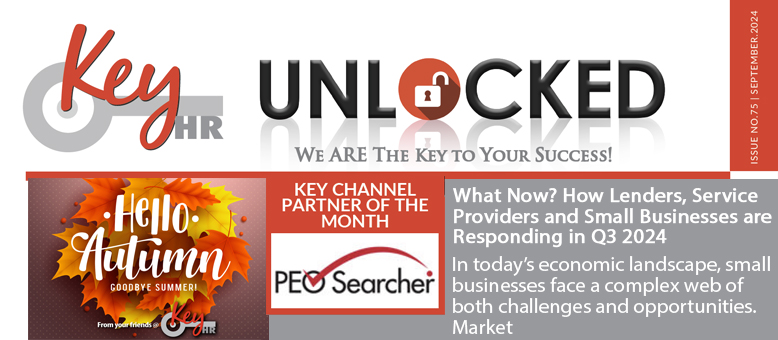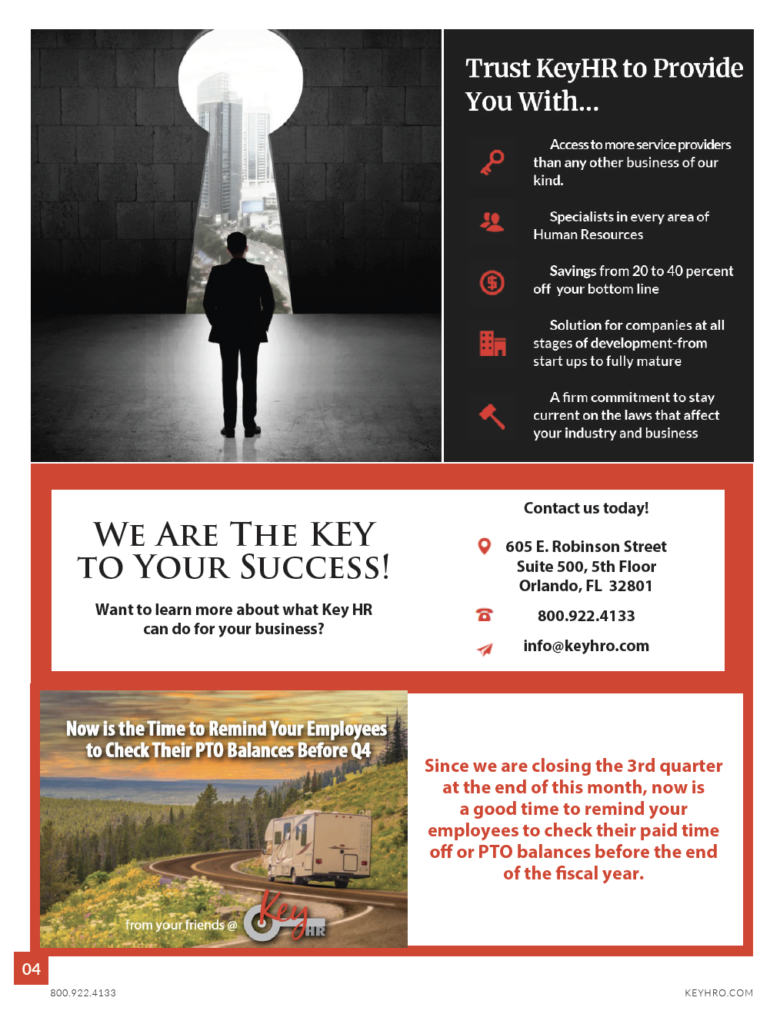
KEY HR UNLOCKED Newsletter – ISSUE NO. 75 | SEPTEMBER . 2024


How successful could you be if you could focus on what you do best? It’s a question worth asking. And we not only HAVE the answer… We ARE the Key!
KeyHR is aligned with preferred provider companies to offer new and innovative ways to meet out clients’ payroll, employee leasing, benefits and insurance needs.
Our relationship with these companies helps business owners reduce costs, save time, optimize their workforce, increase revenue and minimize risk. If your company needs to save money, address compliance issues, improve efficiencies and increase productivity, we have the solutions.
If your company needs to save money, address compliance issues, improve efficiencies and increase productivity, we have the solutions and the key to your success.
Trust Key HR to provide you with…

- Access to more service providers than any other business of our kind
- Specialists in every area of Human Resources
- Solutions for companies at all stages of development – from startups to fully mature
- A firm commitment to stay current on the laws that affect your industry and business
- Savings from 20 to 40 percent off your bottom line
- It could be one of the smartest business decisions you ever make!

What Now? How Lenders, Service Providers and Small Businesses are Responding in Q3 2024
In today’s economic landscape, small businesses face a complex web of both challenges and opportunities. Market trends and financial dynamics influence these complexities. We understand there are multiple pain points, but we also see hope. Let’s explore how these factors are shaping the small business environment.
Defaults and Delinquencies
The recent Small Business Indices show an increase in defaults (84 basis points year-over-year) and delinquencies (17 basis points year-over-year) among small businesses. This uptick can be attributed to decreased consumer spending and higher interest rates. The uptick impacts businesses ability to manage debt effectively.
Despite these challenges, optimism remains high among business owners. 93% of business owners expect moderate to significant growth over the next year. This optimism underscores the resilience and determination of small business entrepreneurs in the face of economic headwinds.
Lending Environment
From a lender’s perspective, there has been a noticeable tightening in lending practices. Lenders are more critical in evaluating loan applications. This is due to constraints in available cash. Consumer and commercial savings are down. Reduced savings is putting pressure on lenders and their ability to facilitate lending activities. In response, these lenders have shifted their focus to targeting new consumer and commercial accounts as well as upselling current customers in an effort to encourage increased deposits.
Service Providers
Based on customer feedback, service providers, like communication companies and insurance providers, are also navigating the economic shift through increased targeted marketing efforts. strategies. Service providers are leveraging data to identify growth opportunities among small businesses. At the same time, there’s a heightened awareness of potential fraud risks. This prompts providers to enhance their risk management practices.
Small Business Strategies
For small business owners, accessing capital is crucial for sustainability and growth. However, the high interest rates associated with traditional business loans have led many to explore alternative sources of capital. Alternatives include third-party funding or reinvestment of personal savings and cash flow.
In terms of services, businesses are prioritizing essential needs over discretionary spending. They are focusing on proven strategies and areas of success rather than venturing into new, untested markets.
Navigating Forward
As the small business landscape continues to evolve, adaptation and strategic planning will be key. Businesses best positioned for growth:
• effectively manage their financial obligations,
• leverage available resources, and
• adapt to changing consumer behaviors.
While challenges like increased defaults and stringent lending practices exist, the prevailing optimism among small business owners signals a resilient entrepreneurship. By focusing on prudent financial management and targeted growth strategies, small businesses can navigate today’s economic uncertainties and thrive in upcoming quarters.
www.shrm.org

Supercommunicators: Tips for Having Better Work Conversations and Meetings
Five lessons for your work and personal life from the new book Supercommunicators, by Pulitzer Prize-winning journalist Charles Duhigg.
It’s a great season for new book releases related to the future of work, and this piece is aimed at getting you up to speed on the central learnings from one published recently, Supercommunicators by Charles Duhigg.
I asked Duhigg, a Pulitzer-Prize-winning journalist who also wrote The Power of Habit, what the most important takeaway for people leaders from his new book is and he replied:
“There was an excerpt in The Wall Street Journal that makes for a pretty good summary of some of the key skills. But, in general, I would say:
Leaders who want to connect with their teams should listen more and ask more questions (supercommunicators, we know from studies, ask 10 to 20 times as many questions as the average person), and in particular they should ask deep questions. Something that invites the other person to discuss their values, or beliefs, or experiences. There are a few examples in the Journal piece.
“And then the other important thing (among many) is to show the other person or group you want to connect with them. The desire for connection is innate–but it can also feel vulnerable. When we show we want to connect—by asking someone about their life, by asking follow-up questions, by proving we’re listening, by sharing meaningful things about ourselves—it is a signal to another person that we want to make a real connection with them, and we almost always respond by accepting that invitation. Our brains, in fact, have evolved to nudge us that way.”
I read Supercommunicators this week, and a few other things relevant to workplaces stood out for me:
• Prepping conversations beforehand makes them better. Researchers studying a group of investment bankers who had contentious, high-pressure meetings found that they could make them less fierce by asking everyone to write one sentence before each meeting explaining their goals for it. Duhigg recommends asking yourself a few questions in the moments before a conversation, such as “What are two topics you most want to discuss?” and “What is one question you will ask that reveals what others want?” (p. 71)
• Shared laughter is a powerful strengthener of bonds between people. Laughter is powerful, Duhigg writes, citing a psychology researcher, “because it is contagious, ‘immediate and involuntary, involving the most direct communication possible between people: Brain to brain.’” (p. 113) People laugh to connect with other people, and it doesn’t need to be around things that are particularly funny. The researcher found that most times in conversation people are laughing at banal remarks such as “It was nice meeting you too.”
• You can ask common questions slightly differently and create more space for connection. Rather than just “Where do you live?” or “Where did you go to college?” you can try “What do you like about where you live?” and “What was your favorite part of college?” (p. 97) “Those questions make emotional replies easier, and they practically beg the questioner to reciprocate— to divulge, in return, why they work here, what they enjoyed about college— until everyone is drawn in, asking and answering back and forth,” Duhigg writes.
• “Looping” creates a foundation for understanding. This is when you repeat back in your own words what someone has said, and then ask them to confirm that you got it right. “Studies show it is the single most effective technique for proving to someone that we want to hear what they are saying,” Duhigg writes. (p. 142) It helps prevent things from heating up during hard conversions and people who practice looping are viewed as better teammates and advisors.
Here’s one more takeaway from Supercommunicators that’s perhaps useful for your personal life and relationships:
• Researchers have found that happy couples get in sync about the purpose of the conversation they’re having at the moment. “On a very basic level, if someone seems emotional, allow yourself to become emotional as well. If someone is intent on decision-making, match that focus. If they are preoccupied by social implications, reflect their fixation back to them,” Duhigg writes. (p. 21) “Happy couples ask each other more questions, repeat what the other person said, make tension-easing jokes, and get serious together. The next time you feel yourself edging toward an argument, try asking your partner: ‘Do you want to talk about our emotions? Or do we need to make a decision together? Or is this about something else?’”
You can buy a copy of Supercommunicators from Bookshop or Amazon. And you can read our archive of book briefings for critical summaries of other books relevant to leadership and work.
Reading Supercommunicators reminded me of the work that Deb Roy is doing at MIT around constructive communications in the workplace. “It’s extraordinary what will happen when you give people a space to share personal experiences and then create possibilities for people to listen and to hear one another’s experiences,” Roy says.
www.shrm.org

With students heading back to school and open enrollment just around the corner, it’s a great time to realign efforts around benefits education to support your busy employees — especially those who are also juggling school schedules, family costs, and end-of-year planning. Open enrollment is an excellent opportunity to help employees plug into the valuable support available through your financial benefits programs, but it’s essential to strike the right balance of benefits communication, education, and offerings to help get the right information to the right people at the right time. Mastering this recipe is an ongoing challenge — in fact, 85% of employees believe their company needs to do a better job explaining how to maximize the financial benefits offered, and 96% of HR leaders agree, according to Morgan Stanley at Work’s State of the Workplace 2024 Financial Benefits Study.
Here are 3 ideas to help kickstart your back-to-school and open enrollment seasons with reenergized employee engagement:
1. Tailor your benefits education program to be inclusive of all employees The workplace is a primary resource many employees turn to for help reaching financial goals, but they may need help connecting the dots between your benefits offering and their financial obligations —whether that includes caretaking, repaying debt, saving for college or more. Our research shows that while 94% of employers offer workplace financial benefits like a 401(k), 32% of employees have never thought to reach out if they need help. For the first time in history, the workforce consists of five generations — which means varying preferences on money management, lifestyle and long-term goals. Our research shows that more than 4 in 5 employees would like their employer to provide support through specific financial troubles, while flagging budgeting (37%), retirement planning (35%), and debt reduction (31%) as top financial issues they’ve dealt with in the past year. With such a diverse set of employee needs, it’s crucial to have both an effective offering and an engaging education program around it to help employees understand how their workplace benefits can help them address various financial challenges.
2. Gather feedback throughout the year and stay nimble Even if your benefits offering doesn’t change very much year to year, it’s important to continually enhance your benefits communications and education content as business objectives and employee needs evolve. As a first step, invite employee feedback on their benefits enrollment experience while it’s fresh in their minds – focusing on what worked well and what didn’t. Then, continue to check in about their ongoing user experience and sentiment throughout the year. Employee feedback can help you identify gaps in your coverage, engagement trends, technological issues, or opportunities to better support company goals. Create a safe space where employees can ask questions and share their opinions.
3. Offer ongoing support To lighten the load for your employees (and make it easier for them to engage), look for opportunities to provide support for a range of financial needs. For example, our research shows that nearly 9 in 10 HR leaders offer financial wellness programs to help counterbalance work-life stressors. Additionally, flexible work
arrangements for caretakers may help relieve gaps in child care, and offering student loan repayment or return-to-work programs can help support education needs. Meanwhile, retirement benefits like a 401(k) employer match can help employees reach their long-term retirement goals.
At the end of the day, back-to-school season is a reminder that learning doesn’t stop after college: Ensuring your company’s financial benefits and related educational programs are inclusive for all employees can help drive a more engaged and financially savvy workforce.
benefitnews.com

Click To download the Key HR Newsletter UNCLOCKED
_________________________________
This communication is for informational purposes only; it is not legal, tax or
accounting advice; and is not an offer to sell, buy or procure insurance.
This post may contain hyperlinks to websites operated by parties other than KeyHR. Such hyperlinks
are provided for reference only. KeyHR does not control such websites and is not responsible for their content.
Inclusion of such hyperlinks on KeyHRO.com does not necessarily imply any endorsement of the material
on such websites or association with their operators
- Posted by admin
- On September 23, 2024
- 0 Comment




